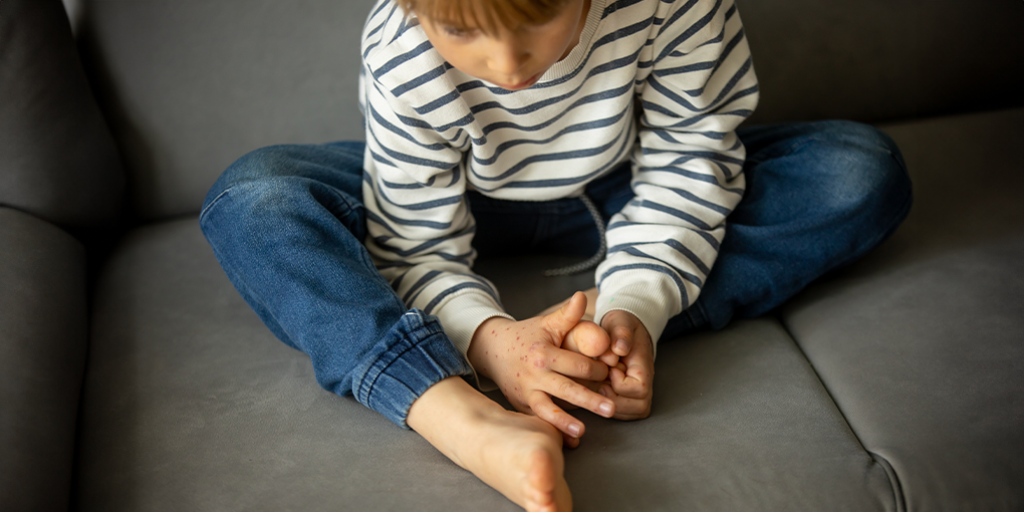Understanding the Spread of Hand, Foot & Mouth Disease

Understanding the Spread of Hand, Foot & Mouth Disease
With kids back at school, it’s time to pay extra attention to contagious illnesses that can spread quickly and make your child sick. Colds and other respiratory illnesses are usually the first that come to mind, but hand, foot, and mouth disease (HFMD) is another very contagious illness that many children end up getting, especially at school or daycare.
Parents, keep reading to learn how to protect your child from HFMD, recognize the symptoms and manage the illness effectively, and know when to seek professional care.
What Is HFMD?
HFMD is a mild yet highly contagious infection that’s most common in children under age 10, with 95% of cases occurring in children under age five. HFMD can also affect older children, teens, and adults, especially those with compromised immune systems.
HFMD gets its name from the blister-like rash that forms on your child’s hands and feet and the painful sores that develop in their mouth. However, the rash can appear elsewhere on their body, including their arms, legs, chest, back, genitals, and buttocks.
How HFMD Symptoms Start
HFMD symptoms typically appear in two stages. Your child will likely first experience flu-like symptoms, such as:
- Mild fever
- Runny nose
- Sore throat
- Stomach pain
- Loss of appetite
After a few days, these symptoms go away, and the rash phase of HFMD starts. The sores typically begin as bright pink spots or tiny bumps and eventually turn into blisters. HFMD sores can be painful, especially the ones in your child’s mouth or on their feet. Thankfully, the rash should subside in 7-10 days (possibly longer for children under age two).
How HFMD Spreads
How does HFMD spread? Easily.
Children with HFMD are most contagious during the first few days of the illness, often before the rash appears. Yet the virus can remain in their body for weeks, long after the visible symptoms are gone.
HFMD is most frequently spread through:
- Contact with an infected person’s saliva or stool and then touching your mouth, eyes, or nose
- Breathing in respiratory droplets after an infected person coughs, sneezes, or blows their nose
- Direct contact with an infected person’s blisters
- Kissing or hugging an infected person
- Sharing utensils, cups, clothing, towels, or other items with an infected person
- Touching surfaces that are contaminated and then touching your mouth, eyes, or nose
Young children need frequent diaper changes and help using the toilet, and they also tend to put their hands in their mouths throughout the day – creating the perfect environment for HFMD to flourish.
Protecting Your Child from HFMD
By implementing some preventative measures at home, you can help protect your child from HFMD and other contagious illnesses.
Wash Hands Often
Wash your hands for at least 20 seconds, especially after using the toilet or changing a diaper. You should also wash your hands before preparing or eating food and after coughing, sneezing, or blowing your nose. Not near a sink? Use hand sanitizer instead.
Teach Good Hygiene
Your child should also wash their hands often, especially after using the toilet, coughing, sneezing, or blowing their nose. Explain why they should never put their hands, fingers, or any other objects in their mouth, especially at school or daycare.
Use Your Elbow
Coughing and sneezing into your elbow – and teaching your child to do the same – is an easy way to help prevent the release of infected respiratory droplets into the air.
Keep Things Clean
You can’t do much about the shared surfaces at school or daycare, but you can make an impact at home. Disinfect any high-touch items – such as toys, countertops, faucets, and doorknobs – and wash your child’s clothing and bedding frequently.
Stay Away
Keep infected children away from healthy children whenever possible. If your child is sick, they should stay home from school or daycare until their fever and other symptoms are gone. Always avoid close contact with an infected person, such as kissing or hugging them.
Relieving HFMD Symptoms
There are also things you can do at home for your child to help relieve their HFMD symptoms, including:
- Over-the-counter pain relievers, such as Tylenol or Advil (never give aspirin to children under age 16 unless directed by a doctor)
- Topical oral anesthetics, such as Orajel or Anbesol
- Gargling with salt water
Your child probably won’t want to drink much if they have painful mouth sores, but they must drink enough to stay hydrated. Avoid warm or hot liquids and acidic juices, which can aggravate your child’s sores. Instead, offer cold liquids like water, milk, or Pedialyte. Your child may enjoy sucking on ice pops – whatever it takes to keep them hydrated.
When to Seek Professional Care
Contact a pediatrician or urgent care provider right away if your child:
- Has severe itching or blistering
- Has a fever that lasts more than three days
- Isn’t drinking enough liquids to prevent dehydration
- Doesn’t improve after 10 days
Feel Better Faster® with TrustCare Kids
When HFMD and other unexpected illnesses strike, TrustCare Kids is here to help your family get through them.
TrustCare Kids offers urgent care services seven days a week on a walk-in basis and pediatric primary care by appointment. We’re open late and on weekends, so you can avoid the emergency room and get quality care you trust. Come visit us soon!
